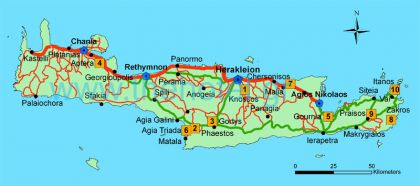1) Knossos
It is the most famous of the palaces of the Minoan civilization. It was destroyed possibly by a volcanic eruption about 1450 BC. The ancient Knossos was the hub of the Minoan Civilization which imposed the Aegean 4000 years ago. According to mythology, the palace was the seat of the king Minos. It is also connected with intriguing legends, such as the myth of the Minotaur in the Labyrinth under the Palace, and the story of Daidalos and Ikaros.
The Palace of Knossos is the largest and the most spectacular of all the Minoan palatial centres. The Palace spread over 20,000 square meters (2 hectares) of land with heights reaching four stories. It was constructed in a labyrinth-like pattern and it provided housing for about 100,000 people. Colourful friezes and frescoes, figures and paintings on plaster fill the walls of the palace and exhibit life from this era. There are varying pictures from animals and people to gods and various ceremonies, which depict an advanced and sophisticated society. Further examination of the Palace's interior decoration reveals that war was not a common theme and women were depicted almost as frequently as men.
2) Phaestos
It is another palace of the Minoan civilization built around 1600 BC. Its ruins (a maze of walls and courtyards) are second only to those at Knossos. The site of Phaestos is preserved in its natural state. The unique clay disc from Phaestos (dating from 1600 BC) is one of the most valuable exhibits in the Museum of Herakleion since it is one of the oldest examples of hieroglyphic writing ever found and it is believed to record a hymn to the goddess Rhea.
3) Gortys
The site contains the ruins of the city of Gortys, with basilica, the remnants of a Roman provincial governor's palace which dates from the early Christian era, and the ruins of the acropolis and the odium of the ancient Gortys. The Basilica of Agios Titos is one of the oldest and most important monuments of Christianity in Crete and it was the seat of the first bishops of the Cretan Church.
4) Aptera
Aptera was one of the most important city-states of Crete. According to the legend Aptera (meaning wingless) named after the defeat of the Sirens in a music contest. The Muses cut the Sirens' wings and when they tried to fly, they fell into the water and formed the small islands in Souda bay.
The first epigraphic occurence of Aptera is found in the Linear B tablets (14th - 13th century B.C.). It became a very important city-state during Greek times and it was involved on the Cretan wars. The city flourished until the 7th century A.D. when an earthquake destroyed it. Its ideal location was determinative for its development in an important commercial and political center. Aptera was able to control the naval activity by harbors, Kissamos and Minoa, located on both sides of Suda Bay.
The era of the city's greatest peak was the early hellenistic period (late 4th - 3th century B.C.). At that time Aptera begins to mint its own coins and develops diplomatic relations with important centers of the hellenistic world. During the period of roman occupation it appears to have developed a more rural character. Habitation at the site continued into the early byzantine period. After the 7th century destruction, the monastery of Saint John the Theologan was established in the central area of the city and it officiated until 1964.
The ruins which are exhibited in the site come from different historic periods: enormous Roman cisterns, foundations of a Demeter temple, a Dorian temple, a Hellenistic Apollo temple are interspersed with a Byzantine cloister and a large Turkish castle.
5) Gournia
It is one of the oldest sites, dating from 3000 BC and it is the best preserved Minoan town in Crete. However, it was a town of workers with their workshops surrounded by a small palace.
6) Agia Triada
It is located 3 Kms west of Phaestos and it is an L-shaped Minoan Villa. Here it was found a treasury of Minoan relics such as tablets.
7) Malia
3 km east of the famous Malia there is an ancient palace site.
8) Zakros
Remains of fourth greatest Minoan Palace and a cistern can be seen.
9) Praisos
Here you can see the remnants of a temple, house foundations and a city wall. It was the last enclave of the descendants of the Minoans (Eretocretans).
10) Itanos
It is the location of a flourishing city until the Medieval Time. Here there are the remains of a Hellenistic Wall, of two early Basilicas as well as toppled walls and columns.



